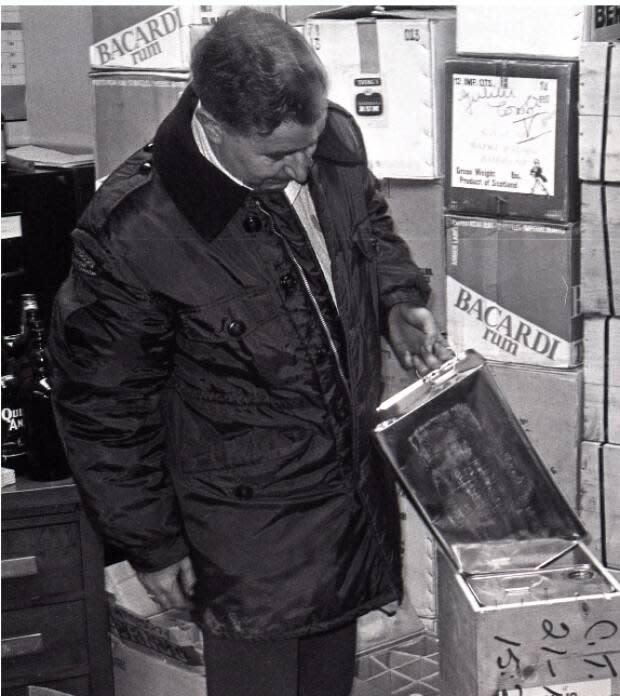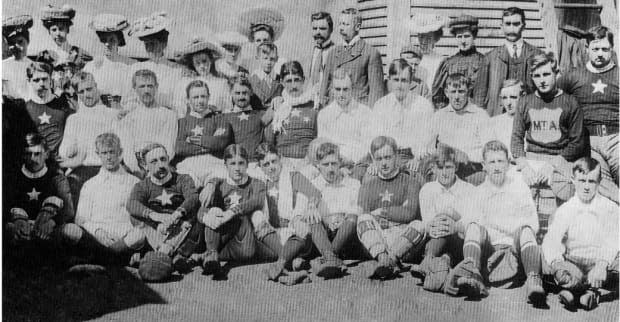Soccer teams and rum-runners — the ties that bind Burin and St-Pierre-Miquelon

The Burin Peninsula has always had very close relations with the nearby French islands of St-Pierre-Miquelon.
These ties have even grown stronger in recent years as many of the French residents now vacation and shop in Newfoundland and Labrador, and an increasing number of them are purchasing summer homes in this area.
During the summer, hundreds of tourists find their way to the French archipelago via a ferry service from Fortune. However, for more than 100 years, St-Pierre-Miquelon — especially from October to December, encompassing Thanksgiving and Christmas celebrations — has meant something much more than a tourist attraction to many Newfoundlanders.
Until just a couple of decades ago, much of the liquor consumed in southern Newfoundland came illegally from the French islands, and many a tin of alcohol and 60-ounce bottles of over-proof rum found their way into St. John's via the Burin Peninsula highway.
Even as far back as the mid-1800s, Newfoundland customs officials estimated that the then independent country was being robbed every year of about $50,000 in taxes as a result of smuggling from the French islands.
Many a tale can be told of Burin Peninsula rum-runners in their little fishing dories and skiffs eluding RCMP patrol boats while returning from St. Pierre with a load of booze.

There were times, however, when they would be forced to dump their liquor overboard as a police cutter speedily approached; their cargo was safe in bags packed with heavy salt that would dissolve, allowing it to float back up to the surface, where it could be picked up later.
Over the years, especially in the 1980s and 1990s, the amount of liquor and cigarettes coming illegally from St-Pierre-Miquelon increased at an alarming rate, with more Newfoundlanders getting involved in the very profitable but risky activity.
It finally became such a big commercial operation that laws were enacted for it to be treated as a major crime, with the courts increasing fines and confiscation of property and often jail time for many of those caught and convicted.
A 1994 RCMP raid at Terrenceville, code-named "Operation Bacon," resulted in contraband and assets being seized with a total value of over $300,000.

An increased permanent police presence on the Burin Peninsula, coupled with faster boats and those tougher laws, meant Burin Peninsula smugglers had to face the possibility of losing everything they owned, and the movement of illegal liquor and tobacco from the French islands today is only a shadow of what it once was.
Throw in strict COVID-19 travel restrictions, and 2020, as one gentleman told me, "was a very dry Christmas as far as cheap liquor is concerned."
Seven decades of soccer history
Not all of the kicks shared between the islands have been illegal.
From 1906 to 1978, Burin Peninsula and St. Pierre soccer teams made many reciprocal visits that helped strengthen the ties between our two countries.
In 1906 Grand Bank played its first game of international football, against the ASSP club from St. Pierre. On July 14 of that year the tug St. Pierre left the French islands for Grand Bank with the team and several dozen supporters aboard.
According to a newspaper clipping of the day, datelined St. Pierre, "the welcome was beyond anything we ever expected."
The game was played the next day.
"After a rather rough and hard fought contest the French team scored one goal, a few minutes before the finish, to win 1-0. The French boys were then taken to the Masonic Hall to enjoy a very nice lunch."
Later that summer, on Aug. 29, the Grand Bank team visited St. Pierre for a return match. A newspaper clipping from the next day, datelined Grand Bank, explained that the St. Pierre carried 36 passengers, including the football team, out to the French islands.

"We were welcomed very cordially by our French friends, and were soon supplied with comfortable boarding houses. On awaking on the morning of the 29th, it was felt by all that an eventful day had arrived, and we were not mistaken. We can truly say that the day was 'Unprecedented in its Enjoyment' in the history of Grand Bank.
"'What made it so?' some ask. We answer, 'The royal and welcome way in which we were received by the ladies and gentlemen of St. Pierre.' No praise of our reception can be too complimentary. In the morning we were taken out for a drive by the members of the French football team, in wagons which were decorated with flags to suit the occasion. At 2 o'clock the football match was played. The British Consul at St. Pierre acted as referee.
"The St. Pierre brass band marched with us to the football grounds treating us with some lively music on the way. The match was very exciting from beginning to end, but it proved to be a one-sided game, the score being three to nil in favour of the French. However, we expect to do better next summer."
Over the years the visits between the French islands and Grand Bank were much more than soccer games.

Usually two or three dozen fans would accompany the players. It was one of the highlights of the year for both communities. Lavish banquets, dances and renewing old friendships were the order of the day.
Photos of both teams had to be taken and it became a tradition that at least one photo had to be taken of the players from both teams posing together, often with their arms interlocking each other.
Life on the nearby island
The tidal wave that struck the 'the boot' of the Burin Peninsula on Nov. 18, 1929, killed 28 people and left hundreds more destitute.
People in Burin, St. Lawrence, Taylor's Bay, Point au Gaul and Lamaline could only watch helplessly as their fishing boats and gear, stages and flakes were destroyed or washed out to sea by the giant tsunami that crashed ashore there.
Their means of earning a livelihood was gone and in many cases families had no choice but to leave.
Meanwhile the economy in nearby St-Pierre-Miquelon was doing quite well, thanks to Prohibition in the U.S.
At least 15 men from St. Lawrence decided to move to the French Islands to sign on as crew members on rum-running vessels, ferrying contraband liquor to a rendezvous point just off the American coast.
Most of the men and their families eventually did return to St. Lawrence but several, including John and Nora Cusick, put down their roots at St. Pierre and remained there.
The Cusicks had six children, who were all born and grew up in St. Pierre. One of the children, Therese, moved to St. Lawrence when she married Herb Slaney in 1952.
Adjusting to a different lifestyle and traditions in St. Lawrence "was a culture shock," said Slaney, now 87. Doing her best to communicate in her broken English in the early years and also missing her family were huge challenges for her, she explained.

Even though St. Pierre was nearby, having eight children to raise meant that trips there were limited.
However, her husband's deep involvement in soccer meant that some of her family and friends would visit when the French team came each year to play in St. Lawrence.
The French dance music known as musette — mostly a rapid waltz or other kind of two-person dance played with the accordion — has always been very popular at St. Pierre.
Therese's late husband Herb was noted for his love of music and his ability to tickle the ivories. Often when they visited the French islands he would be called upon to play.
"Growing up we were very close to our grand-mère," Therese's daughter, Lisa, told me. "She always came to visit in September, and when we girls got older we went ourselves to spend a month in the summer with her. We had a lot of French cousins, aunts and uncles, who we are still in touch with."
Grand Bank native Holly Penwell moved to St. Pierre in 1995, and two years later married her French boyfriend, Jean Marc Briand.

Doing her best to adjust to an entirely different culture while trying to learn a new language proved to be quite a challenge.
To talk to each other, the couple at first used an English/French dictionary; for Penwell to communicate at all with others, like when she would answer the phone, she would memorize some common French sentences.
Coping with isolation on the small island was also difficult, especially during the winters in the early years when there was no regular ferry service.
However, well qualified with her previous teaching experience as well as her bachelor of education and a master's in education administration from Memorial University, she earned a diploma in teaching a second language and started teaching at MUN's campus on the French island in 1997.
Four years later Penwell went to work for the St-Pierre-Miquelon government in a music and arts school where she remained for 16 years, until she and her son, Luc Briand, moved to France proper in 2017.
Penwell recently passed France's national exam — placing 43rd out of the 350 people who wrote it at the same time — qualifying her to teach in that country.
She is teaching in France and her son, Luc, is attending university there; both of them now hold dual Canadian/French citizenship.
Many people from St. Lawrence to Point May on the Burin Peninsula can trace some of their ancestry to St. Pierre, no doubt because of their closer proximity to the French islands than towns like Grand Bank, Fortune and Garnish.
Lisa Loder, Therese Slaney's daughter, is among them, with a strong attachment to the French islands.
"We all loved St. Pierre — the chocolate, pastries and bread, and the friendliness of the people on the island," she told me.
"It was a special unique little place with a different culture that holds many wonderful memories as a child, and when I visit any time as an adult I still get that excitement."

